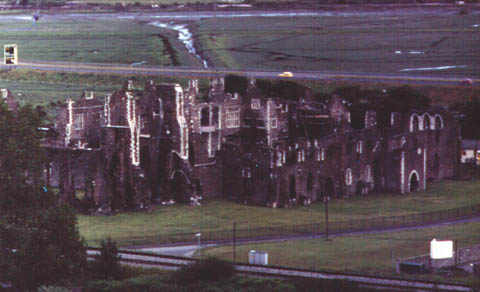The Abbey did not suffer during the Despenser War, when Neath Castle and the town were attacked. The sympathies of the Abbey were with Edward II who for a week in November 1326 lodged at Neath but was captured and murdered in prison at Berkley. The discovery as recently as 1956 of a hoard of silver pennies hidden in a crevice in the west range of Neath Abbey points to their having come from this period. The Abbey lapsed into obscurity during the early 15th Century and suffered during the wars of Owain Glyndwr but the situation improved in mid-century when the Register of Neath Abbey was written, recording all the charters granting its lands and privileges. The monks were then holding a school for children in the abbey and were patrons of Welsh bards. An eisteddfod was even held there in 1490. There was much prosperity under the Abbey's last abbot Leychon Thomas. Careful in estate management, he changed the Abbey's direct land cultivation in its granges to a system of rents and leaseholdings and by 1533 he had granted fifty one leases, which left the Abbey owning only a compact estate around itself, the area of Cwrt Sart and Cwrt-y-Bettws today. Thomas paid great attention to the fabric of the Abbey, and a local poet, Lewis Morganwg, has described its brilliant stained glass, the gilded tabernacle work, the church walls of grey marble and white limestone, and the floors of many - hued tiles, above which rose the vast, lofty roof with golden ceilings. John Leland, too, about the year 1536, described the abbey as "the finest abbey in all Wales". The poet also describes the comfort enjoyed by the Abbot - "in this compact retreat will be found the warmth of hospitality and welcome banquets and deer from the parks of yonder hill above and salmon from the ocean and wheat and every kind of wine". And yet by 1539 the annual revenue of the Abbey is recorded as being only £132.7.7d.
Finally, in March 1539, when only seven monks remained, the Abbey was dissolved under Henry VIII and Abbot Thomas retired with a pension of £40 per annum to the nearby Rectory of Cadoxton, dying there in 1553. There are many pictures of Neath Abbey on the Coflein site (the online database for the National Monuments Record of Wales) including a drawing of how the site may have looked in its prime, and modern aerial pictures from 2008 and 2010.
The Abbey lands were soon dispersed but the main estate around the Abbey - including the coal pit - passed to Sir Richard Williams (or Cromwell). The Abbey itself was destroyed piecemeal - four bells were sent to Bristol to be melted down. In the late 16th Century the abbot's house was converted to a fine Tudor country mansion by Sir John Herbert and the Herbert family resided there during the 17th Century, the property later passing to the Doddingtons and then to the Hoby family. After Philip Hoby's widow died in 1699 the Abbey was given over for industrial purposes! The industrial development of part of the Vale of Neath bought copper smelting close to the Abbey ruins and so, possibly as early as 1721, actual forging processes were being carried out within the west range, in the Abbey kitchen and outside the west front of the Abbey Church. The reddening caused by the fires can still be seen in the dormitory and on the walls near the outer porch. The decaying Herbert mansion was used to house the workmen and their families.
"
Advertisement for the sale of the Neath Abbey Estate (The Times, 20 September 1836)
No wonder a gentleman on an architectural sketching tour of South Wales early in the 19th Century was moved to lament - "Neglected Neath Abbey, once the ornament of a lovely Vale, looms up through its dense veil of smoke like the skeleton of a stranded ship crumbling piecemeal to decay under the influence of almost perpetual rain". Meanwhile, some of the greyish-white Sutton stones of the Abbey had been taken away and a few may still be seen in the walls of old cottages in the village of Neath Abbey and some, too, in the base of the tower of Neath's St. Thomas Church (rebuilt in the 16th Century).

Postcard - Neath Abbey Ruins and the Tennant Canal
The cutting of the Tennant Canal came in 1824 and the canal still passes to the south of the Abbey ruins. A railway was built to the north later. And so the industrial encirclement of the Abbey that is to be seen today was completed, and in recent years a dual carriageway has been built to the south, between the Abbey and the River Neath.. Even today ruined Neath Abbey is one of the finest historical buildings in Wales, bearing comparison with Tintern. Fine restoration work has been done in recent years by the Royal Commission on Ancient Monuments and the Ministry of Works, and the Abbey ruins are now open to the public on visiting days.

More on Neath Abbey can be seen on John Ball's Welsh Chapels and Churches Collection.